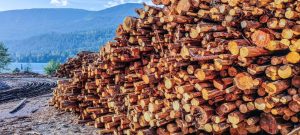
To date, over 26,000 cubic metres of burnt logging residue has been recovered, loaded on a logging truck, and shipped to the Mercer Celgar facility in Castlegar rather than into a waste pile
OLIVER – Aligning with the provincial government’s goal to decrease the burning of slash piles and increase the utilization of wood fibre that has traditionally been wasted, the Osoyoos Indian Band (OIB) and Mercer Celgar (Celgar) are collaborating to rethink conventional practices. With funding from the Forest Enhancement Society of BC (FESBC), the collaboration is helping recover as much uneconomical residual fibre as possible from the OIB’s traditional territory.
This collaborative project is a strategic effort to capture all low value fibre that typically wouldn’t make its way to sawmills and was not economically feasible for non-sawlog products. For example, some of the fibre captured through this project will produce wood chips, and the material not suitable as chips will be used in a product called hog fuel, which will be used to generate electricity. Some of the residual fibre will be chipped in Midway and then sent to the Mercer pulp mill in Castlegar.
The project’s primary goal is to promote diversification and innovation within the supply chain to utilize uneconomical fibre that would typically go unused. By doing so, the collaboration seeks to reduce emissions from slash pile burning, normalize the higher levels of residual fibre utilization, and strengthen reconciliation efforts through collaboration.
Mills have long been adept at utilizing various types of residual fibres to create different products, but this project takes things a step further. To maximize fibre utilization, funding from FESBC is incentivizing tenure holders, excluding BC Timber Sales, and contractors to now consider forest stands that were historically deemed economically unviable to harvest.
Celgar and the OIB are looking to examine the difference in cost between harvesting and selling pulp logs – a lower-value log that generally can only be used to create pulp for various products, including paper, tissue, and food packaging and to determine how operations can be modified to bridge the divide. By working together, they’re developing a cost model to help address the recovery of uneconomic fibre, ensuring this wood can be delivered to non-sawlog facilities, in essence, making sure it doesn’t go to waste.
According to Chris Longmore, Manager, Fibre Procurement, with Celgar, FESBC funding has gone towards utilization and rehabilitation from at least seven wildfire-impacted areas spread across the Arrow, Boundary, Okanagan, Kootenay, Revelstoke, and Golden timber supply areas, including the Octopus Creek wildfire which burned more than 22,000 hectares of forest and the Michaud Creek fire, which burned over 14,000 hectares of forest.

Mercer Celgar operations in Castlegar, B.C.
To date, over 26,000 cubic metres of burnt logging residue has been recovered, loaded on a logging truck, and shipped to the Mercer Celgar facility in Castlegar rather than into a waste pile. That volume will continue to grow in 2024 as efforts continue to focus on utilizing fibre from burnt stands fibre.
“The financial support from FESBC has played a crucial role in bringing together project partners, particularly First Nations, to embark on this transformative journey. This funding highlights the importance of collective efforts in redefining forest management practices and sets the stage for a more sustainable future,” said Longmore.
The collaboration between Celgar and OIB with FESBC funding is helping to raise the bar for higher levels of fibre utilization, mitigating the impacts of climate change by reducing emissions from slash burning and working in collaboration with First Nations.
According to FESBC Operations Manager Brian Watson, “This program not only provides opportunities for the logging community that is supplying the logs to the Celgar pulp mill, logs that would be burned, but the program is meaningfully reducing carbon emissions associated with the changed behaviour. By creating a wood product, approximately 64,000 tonnes of carbon entering the atmosphere will be avoided. This is the same emissions that 13,800 mid-sized vehicles would produce in 1 year.”
Revelstoke has seen a direct benefit, with $230,000 coming into the community as payment for the use of the Revelstoke Community Forest Corporation log yard for this project. Many other communities in the southern interior are also indirectly receiving an infusion into their economy from this project through the logging community and the businesses that service them.
Currently, the project is 65 per cent complete, and even upon completion, according to Longmore, Celgar will continue to maximize the recovery and utilization of uneconomical fibre while reducing carbon emissions via collaboration with land tenure holders and their logging workforce in the southern interior. This change in culture to continue to pursue full forest utilization sets the stage for a lasting positive impact for both the forest industry and the environment.
Dan Macmaster, Forest Manager at the OIB, highlighted the significance of sustainable resource use for the OIB, stating, “Fibre utilization through proper forest management results in less burning of debris piles, cleaner air and waterways, and financial benefits from processing pulp volume that would normally be left behind. FESBC has provided the funding to help local contractors haul this volume over long distances to the Celgar mill, creating jobs, incentivizing fuel mitigation projects, and adding value to pulp fibre that would otherwise be burned.”
As the project aims to haul approximately 128,000 m3 by March 31, 2024, efforts will continue well into the future to maximize the recovery and utilization of uneconomical fibre.
“Managing the larger landscape for wildfire risk reduction, climate change adaptations, and mitigating insect infestations is critical to the OIB,” shared Macmaster. “This FESBC project has provided the means to meet numerous management objectives on our traditional lands.”
Source: Forest Enhancement Society of BC

